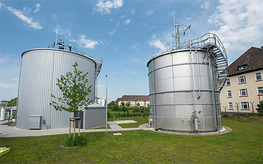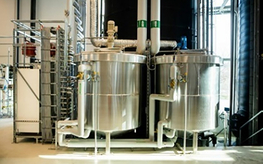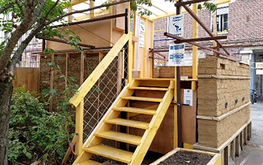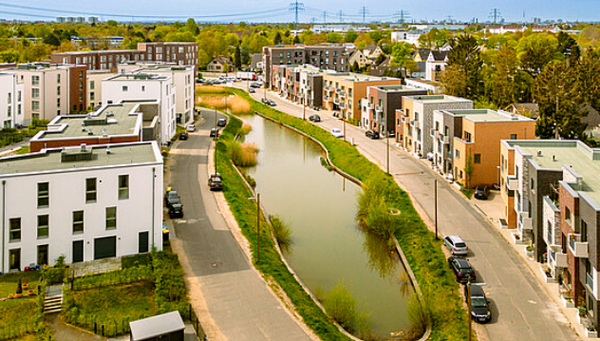News Detail
Innovative water solutions for sustainable cities
August 13, 2024 |
Climate change, diminishing water resources and a rapidly growing urban population are forcing us to rethink water management. Major cities around the world such as San Francisco, Cape Town, Bengaluru or Barcelona are struggling with recurring water crises. “We need new approaches to increase the resilience of cities against increasing drought problems,” says Christian Binz, Group Leader in the Department of Environmental Social Sciences at the aquatic research institute Eawag. “One solution is to recycle the water locally. This creates a reliable source of water during drought periods, for example in major cities in India, Africa and increasingly also North America. But recycling the resources contained in wastewater, such as energy and nutrients, is also becoming increasingly important.”
Lighthouse cities show the way to sustainable water and sanitation solutions
For more than 20 years, Eawag has been developing innovative urban water management solutions that manage water and the resources contained in it in small-scale cycles. In interdisciplinary teams, the aquatic research institute also investigates how the new technologies can be put into practice. To this end, researchers have analysed major cities around the world that have successfully adopted circular approaches to water management in recent years, including San Francisco, Bengaluru, Hamburg, Paris, Geneva and Helsingborg.
“We have realised that many exciting solutions for circular water and wastewater management are already in operation around the world,” says Christian Binz. “However, many of the key players still hardly know of each other.” In summer 2023, Eawag together with the University of California, Berkeley, and the consulting company BlueTech Research therefore invited leading experts from cities, companies, international water organisations and investors like the World Bank to a workshop in Dübendorf.
Eawag has summarised the results in a white paper entitled “Mainstreaming Decentralised Urban Water Management Solutions for Sustainable Cities”. In addition to the description of the lighthouse cities, the centrepiece is three roadmaps. They show three different paths of implementing circular water solutions on a broad scale: (1) reuse of non-potable water at building level, (2) district-scale resource recovery and (3) decentralised nutrient management. “With the workshop and the white paper, we want to build an international network through which ideas and knowledge on circular water solutions can spread worldwide,” says Christian Binz, the workshop’s main organiser. “The description of the lighthouse cities should also inspire urban planners in pursuing more sustainable water solutions in their cities. The aim is that not every city has to start from scratch if it wants to plan, build and operate innovative water systems.”
Roadmap 1: Reuse of non-potable water at building level
One way to close the loop on water use and reduce waste is to equip individual buildings with their own wastewater or greywater treatment plants, treat the water directly on site and reuse it locally. Important steps on this roadmap are to standardise existing technologies, reduce their costs in manufacturing, operation and maintenance, bring them to market on a large scale and convince building owners of their usefulness. Two major cities following this path are San Francisco and Bengaluru.


Left: Blackwater treatment system at the new waterfront neighbourhood Mission Rock in San Francisco (Photo: San Francisco Public Utilities Commission)
Right: Decentralised water reuse plant at a hospital in Bengaluru (Photo: Johan Miörner)
San Francisco’s Onsite Water Reuse System Program was established in 2012 to make the city more resilient to recurring droughts. A city ordinance mandates the installation of on-site non-potable water reuse systems in commercial, multi-family and mixed-use developments of 9,200 m2 or more. In order to build confidence in on-site recycling systems, the city provides technical assistance to stakeholders both locally and through a National Blue Ribbon Commission in partnership with 15 other states.
Treated water is reused for non-potbale uses such as flushing toilets, washing laundry or irrigation. There are currently 43 plants in operation and another 66 plants in the approval process. The city has proven that decentralised water recycling systems can be professionally managed, well-regulated and safely operated. “In 2023 alone, San Francisco’s estimated potable water savings amounted to approximately 46.7 million gallons, equivalent to the yearly water usage of approximately 3,000 residents, and in 2040 the yearly water savings will be the equivalent to the usage of approximately 30,000 residents,” says Paula Kehoe, San Francisco’s Director of Water Resources. Kehoe adds: “Well-run decentralised water reuse programmes help us sustainably manage our scarce water resources, especially during drought years.”
The water situation in Bengaluru is even more dramatic. In the dry season, water becomes extremely scarce and recurring droughts further worsen the situation. At the same time, about 500,000 additional people move to the city every year. Entire building complexes are currently running out of water. Yet, it is impossible to plan, let alone build, expansive pipe and sewer systems for drinking water supply or wastewater disposal in a reasonable amount of time. “We have to treat the wastewater directly on site and reuse it in small circuits. And not just for gardening and toilet flushing, but possibly also for showering, washing machines or swimming pools,” says Shreya Nath, project manager at the NGO WELL Labs in Bengaluru. “During droughts, this is increasingly the only way to reliably supply the population with sufficient water.”
In Bengaluru, all new residential buildings above a certain size must therefore install local wastewater treatment and reuse systems. Over 3,000 systems are currently in operation and recycle around 20 per cent of the city’s wastewater. A market for decentralised wastewater treatment has also emerged in the city. Innovative companies offer solutions that allow apartment blocks to sell their treated wastewater to customers in the neighbourhood, such as laundries, construction sites or industrial companies.
Roadmap 2: District-scale resource recovery
A second innovative route for urban water management is developing circular economy solutions at the neighbourhood level. The most important component of this approach is separating waste streams (e.g. rainwater, greywater and blackwater) at the source, and treating them in district-scale systems that produce service water as well as electricity, fertiliser and heat. In contrast to the previous approach, the spread of this approach does not depend on building owners, but on municipal utilities, changes in urban policy and the development of new strategies by property developers. For Hamburg and Helsingborg, the vision of “net zero” greenhouse gas emissions was the central motivation for embarking on this path.


Left: Digester tanks at HAMBURG WASSER Cycle in which faeces transported in vacuum pipes are used to produce biogas. (Photo: Krafft Angerer / HAMBURG WASSER)
Right: Separate treatment of different waste streams at the RecoLab facility in Helsingborg (Photo: Perfekt, Sara / NSVA)
The Jenfelder Au in Hamburg, with 640 flats and 1,500 residents, is the largest residential area in Europe that has been managing its wastewater using this approach since 2017. The H+ area in Helsingborg has been in operation since 2020, and serves 900 people in 340 flats and 32,000 m2 of office space and also recycles water, nutrients and energy from wastewater. Helsingborg also collects food waste to generate biogas, which is used as a fuel for buses running in the city. “If you want to build sustainable cities, you have to rethink entire city districts and their material flows in a comprehensive manner,” says Hamse Kjerstadius, project manager at the municipal wastewater utility NSVA. “If you want to close the cycles of nutrients, energy, heat and water in an integrative way, siloed thinking in utilities and urban planning departments needs to be bridged in creative ways.”
Roadmap 3: Recycling nutrients at the city level with regional agriculture
The third roadmap goes one step further, focusing on the nutrients contained in wastewater. This approach looks beyond urban boundaries and integrates agriculture in and around cities. The aim is recovering 80 per cent of the most important nutrients – nitrogen, phosphorus and potassium – from urban waste water streams and using them as fertiliser or bio-humus, for example. This requires waste streams in households to be separated at source, for example through the use of NoMix toilets. At the same time, end users in cities and especially local agriculture must be brought on board.


Left: Composting toilet at the Coopérative Équilibre in Geneva (Photo: Coopérative Équilibre)
Right: Dry urinal prototype in Paris (Photo: Ville de Paris / Paris & Métropole Aménagement)
This approach is still at an earlier stage of development due to the high level of coordination required, but also shows strong promise. Two cities that are already pursuing this path are Geneva and Paris. In Geneva, the Coopérative Équilibre has been demonstrating for more than a decade that small-scale nutrient management is feasible. The cooperative has set up compost toilet systems in three housing projects, which are now operated by housing cooperatives. Urine and faeces from the housing projects with 400 to 1,300 people are recycled locally into fertiliser, compost and irrigation water and used in the surrounding gardens.
In contrast to the bottom-up project in Geneva, the city administration in Paris is carrying out an innovative urban development project in the Saint-Vincent-de-Paul neighbourhood. Since 2018, an eco-neighbourhood with around 600 flats, shops and other facilities with circular infrastructure systems has been under construction there. NoMix toilets are used to collect urine separately and process it into fertiliser in local plants, which will then be used in the city’s green spaces by the Green Spaces and Environment Department. Construction is due to be completed soon, with the ultimate aim of connecting more than 4,000 people to the local urine separation system.
Cover picture: The Jenfelder Au residential area in Hamburg is the largest residential area in Europe that has been managing its wastewater in local small-scale cycles since 2017. (Photo: Ulrich Perrey / HAMBURG WASSER)
Financing / Cooperations
- Eawag
- Universität Kalifornien, Berkeley
- Beratungsunternehmens BlueTech Research

